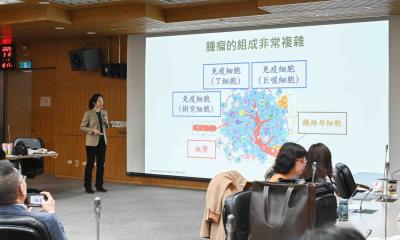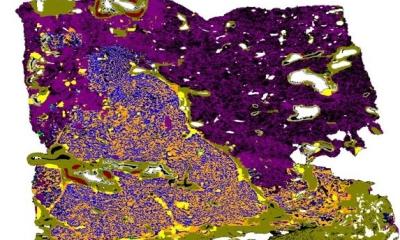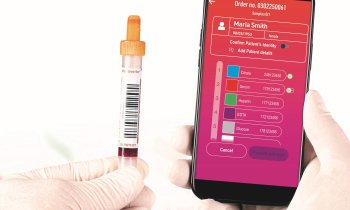
Article • Covid-19 and pathology
Lung cancer care across Europe affected by coronavirus pandemic
The impact of the coronavirus pandemic on lung cancer patient care across Europe, and the contribution lung pathologists, have led to a better understanding of Covid-19, as outlined during the 33rd European Congress of Pathology.
Report: Mark Nicholls
Within ‘The lung pathologist in the Covid-19 pandemic’ session, speakers detailed how the pandemic has affected patients, diagnosis and clinical trials, yet also highlighted the changes pathologists had noted and detailed in lung characteristics as the pandemic progressed. This, they said, contributed to a better understanding of Covid-19 and helped to shape the response.
‘Lung cancer in the Covid-19 pandemic’

In this presentation, Professor Paul Hofman – who had examined the reasons for the decrease in management of lung cancer patients, and consequences of the Covid-19 pandemic for thoracic pathology laboratories in Europe – said patients with lung cancer avoided hospitals because they feared being infected with SARS-CoV-2, and how it would affect their condition.
Care of lung cancer patients was also delayed when appointments and treatment programmes were cancelled. ‘These patients were not treated adequately due to extensive devotion of many physicians to Covid-19 patients,’ Hofman pointed out. ‘Staff members from pathology laboratories were reoriented to work in emergency clinical departments to take part in different activities against Covid-19.’ This resulted in a decrease in molecular analysis in lung cancer during the different waves of the pandemic, particularly in the molecular pathology analyses for genomic alteration assessment in lung cancer.
Biosafety measures
There was also a lower number of patients being included in clinical trials and Hofman highlighted challenges and issues surrounding the use for translational research of human samples obtained during the Covid-19 pandemic from lung cancer patients.
Issues of biosafety measures and biospecimen handling resulted in a decrease of specimens for diagnosis, and fewer collected samples also disrupted translational and basic non-Covid-19 research. A shortage of personnel also impaired routine work and research. However, on the plus side there was a contribution to research on Covid-19 pathogenesis/pathology and a better understanding of the disease.
In addition, the biological safety for personnel working in the pathology lab during Covid-19 had to be carefully assessed and managed with correct training and protocols.
Role of pathologists

Lung pathologists were particularly able to observe the changes taking place in the lung over the waves the pandemic waves. Professor Fiorella Calabrese, from the Department of Cardiac, Thoracic, Vascular Sciences and Public Health (University of Padova, Italy), spoke of current knowledge of pathological lung lesions of Covid-19 and how to recognise and describe the major pathological lung differences through pandemic waves.
Pathologists, she said, had made an important contribution in this respect and had shown that from the first wave, there were three main phenotypes: with prevalent Alveolar Injury (AI); with prevalent Vascular Injury (VI); and with both (mixed type).
The second wave
During this, the most significant difference was a higher frequency of fungal infection, and in particular aspergillus, Calabrese explained. ‘In terms of the important contribution of pathology, and the impact on clinical management, it had delivered clear-cut evidence of different injuries: e. g. vascular lesions. This has increased awareness about some therapeutic strategies (thromboprophylaxis).’ There had been identification of different pathological phenotypes in patients with severe disease and this led to the development of mathematic algorithms to predict different phenotypes.
There were also extensive tissue analyses from full autopsies, which increased a broader understanding of causes of death, because not all patients died due to severe Covid-19 pneumonia. ‘With more superimposed infections – particularly fungal infections (CAPA) – this helped to enable the development of a diagnostic procedure for a more sensitive detection of proven CAPA,’ she added.
The session also heard from Professor Zsuzsanna Varga (University Hospital Zurich), who discussed viral detection in the lung specimens, and Professor Ines Testoni from the University of Padova, who discussed how pathologists had reacted to the pandemic.
Profiles:
Professor Paul Hofman from the Laboratory of Clinical and Experimental Pathology at the Louis Pasteur Hospital in Nice, France, is Full Professor, Head of Human Biobank Unit at the University of Nice and of the FHU OncoAge. He obtained an MD at the University of Nice Sophia Antipolis and PhD at the University of Montpellier and has published more than 500 articles in peer-reviewed journals.
Professor Fiorella Calabrese is a full professor in the Department of Cardiothoracic and Vascular Sciences at the University of Padova, Pathology Section. Her research includes pulmonary pathologies, transplant pathologies, molecular pathology, infectious and immunological diseases, and cardiomyopathies. She has authored 280 publications in peer-reviewed journals, and is past chair of the European Society of Pathology (ESP) Pulmonary Pathology Working Group.
07.10.2021











